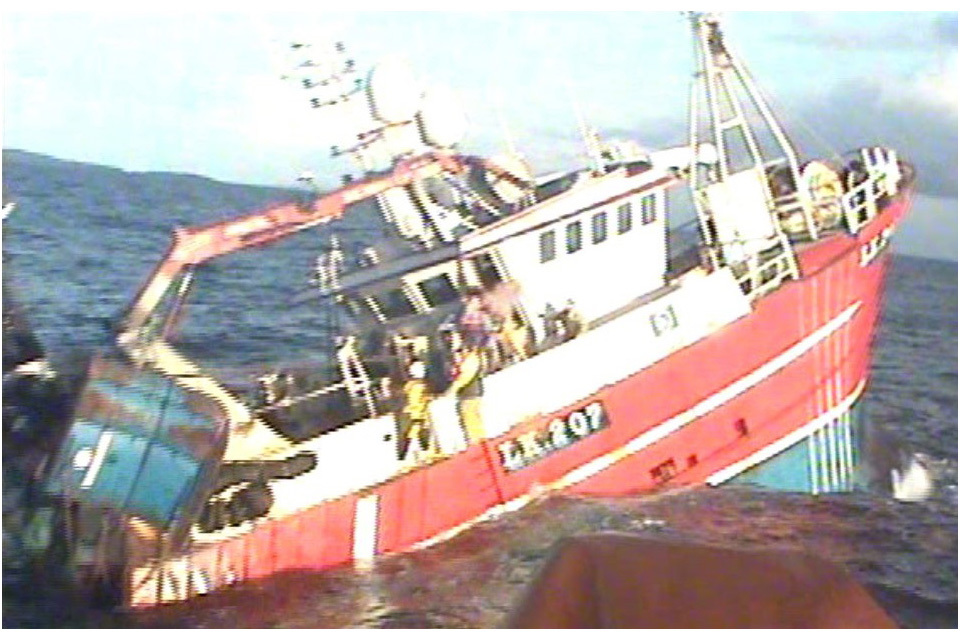Safety flyer to the fishing industry - Ocean Way
Published 24 May 2018
1. Summary
Flooding and foundering of the trawler Ocean Way on 3 March 2017

Ocean Way listing to port and trimmed by the stern just prior to foundering (image: RNLI)
2. Narrative
At 0834 on 3 March 2017, the twin-rigged stern trawler Ocean Way foundered 18 nautical miles north-east of Lerwick, Scotland. Ocean Way’s crew was rescued uninjured and returned to shore by the Lerwick lifeboat. Ocean Way was lost because of an uncontrolled flood in the aft compartment; the source of the flood was almost certainly hull damage caused during the recovery of the port trawl door after the nets had been fouled on an obstruction.
Ocean Way’s aft compartment was separated from the engine room by a watertight bulkhead. There was no bilge suction or bilge alarm in the aft compartment; however, when the flood started, water initially poured into the engine room bilge via a drain valve through the bulkhead. After the engine room bilge alarm sounded, the crew discovered floodwater filling the engine room bilges.
The crew attempted to control the flood using the fixed bilge pumps in the engine room and portable submersible pumps via the aft compartment escape hatch. As the flooding took hold in the aft compartment, Ocean Way adopted a bow up trim that rendered the pumping from the engine room ineffective. In addition, the portable pumps were susceptible to blockages by debris in the aft compartment and the flood was never brought under control. Ocean Way was lost when the aft compartment escape hatch submerged, resulting in overwhelming downflooding.
3. Safety lessons
The crew of Ocean Way could not have done a great deal more to save their vessel. However, post event analysis has shown that there were other possible options to consider. These included potentially increasing the portable pumping effort by early embarkation of the coastguard helicopter’s salvage pump, or containment of the flood by shutting off the compartment. However, it is uncertain that either of these actions would have saved the vessel.
Onboard training and drills had not prepared the crew of Ocean Way for the scale of flooding they faced on the day of the accident. Flooding presents an immediate and potentially overwhelming risk to fishing vessels – it should be considered as dangerous as a fire. Industry guidance is clear that when a flood is detected, the crew’s top priority must be to bring the situation under control ahead of other considerations. Every effort must be made to control the flood by maximising pumping, keeping suctions clear and considering all available options.
The only way crews can be as prepared as possible to deal with foreseeable emergencies is to conduct regular, realistic drills. Use these as an opportunity to develop and then practise potential coping strategies in the event of major flooding. Discussing the scenarios and the response plans before the drill can be a good way of embedding best practice. Conducting a wash-up after the drill will also help crews to gain a shared understanding of how to respond to an emergency and develop the knowledge and skills needed to give them the best chance of saving the boat and/or preventing loss of life.
Our accident investigation report is available at: https://www.gov.uk/maib-reports/flooding-and-sinking-of-stern-trawler-ocean-way
For all general enquiries:
Marine Accident Investigation Branch
First Floor, Spring Place
105 Commercial Road
Southampton
SO15 1GH
Email iso@maib.gov.uk
Enquiries during office hours +44 (0)23 8039 5500

